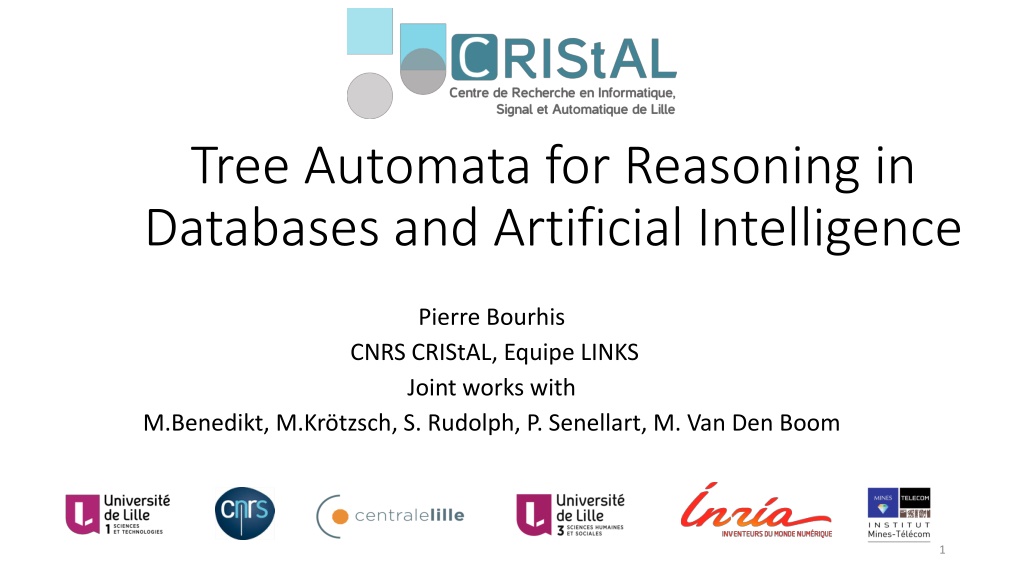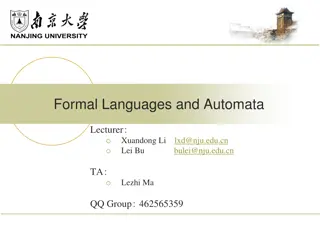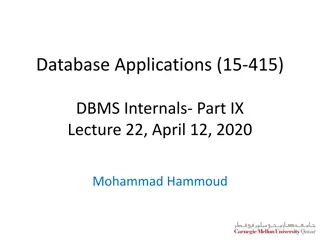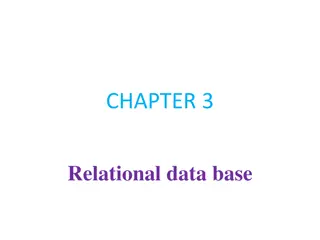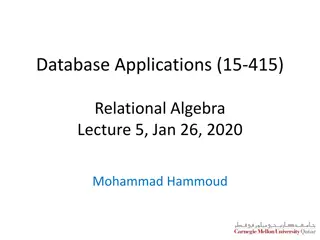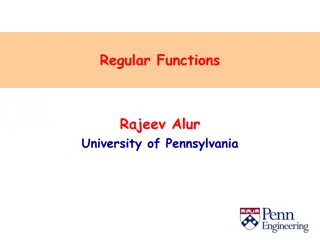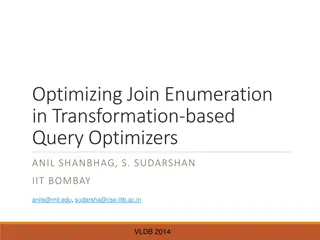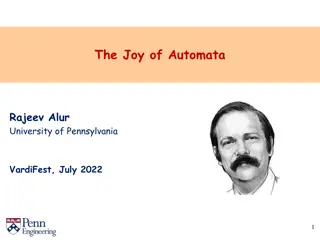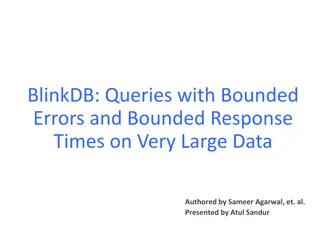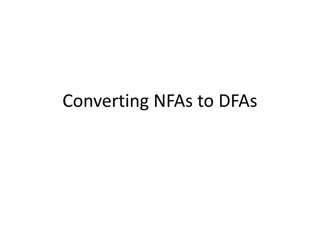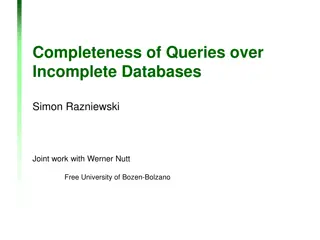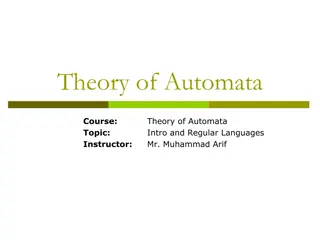Automata for Query Optimization in Databases and AI
Explore the use of tree automata for reasoning, querying databases using logic languages, optimizing queries through relation algebra, and core problems in query optimization. Learn about data exchange on the web, inference of information from incomplete data, and the semantics of Datalog programs for querying relations. Dive into computing path properties and query optimization techniques.
Download Presentation

Please find below an Image/Link to download the presentation.
The content on the website is provided AS IS for your information and personal use only. It may not be sold, licensed, or shared on other websites without obtaining consent from the author.If you encounter any issues during the download, it is possible that the publisher has removed the file from their server.
You are allowed to download the files provided on this website for personal or commercial use, subject to the condition that they are used lawfully. All files are the property of their respective owners.
The content on the website is provided AS IS for your information and personal use only. It may not be sold, licensed, or shared on other websites without obtaining consent from the author.
E N D
Presentation Transcript
Tree Automata for Reasoning in Databases and Artificial Intelligence Pierre Bourhis CNRS CRIStAL, Equipe LINKS Joint works with M.Benedikt, M.Kr tzsch, S. Rudolph, P. Senellart, M. Van Den Boom 1
Querying a database Database : a labelled graph or hypergraph Query : a formula in logic language ex: Conjunctive query, FO, Datalog ?,?,? ? ? ?? ?,? ?? ?,? ?(?) b c a x z y d e f g h i
Optimisation of a query Finding an optimal plan by using relation algebra ?,?,? ? ? ?? ?,? ?? ?,? ? ? = ? ?.1=??.1?? ??.2=??.1?? ??.2=?.1? Minimisation of the query : Removing unnecessary part of the query ?,?,?,?,?,? ? ? ?? ?,? ?? ?,? ? ? ? ? ?? ?,? ?? ?,? ? ?
Optimisation of queries Core problems for the optimisation Inclusion of queries : ? ? Q is included in Q iff for any instance I, if I satisfies Q then I satisfies Q Rewriting a query in a language : Q is rewritable in the language L iff there exists a query Q in L such that Q is equivalent to Q Inclusion: NP complete for CQs, Undecidable for FO
Data on the Web Exchange of data : XML = Trees, Queries based on Tree automata Diffusion of Data : RDF Labelled Graph SPARQL : SQL-Lite Languages with new features (OPTIONNAL) Path Properties x.L.y: Is there exists a path between x and y that satisfies L (regular language) ? Inference of information : Incomplete Data and rules to infer new facts
??????? ?,? ???????? ?,? ??????? ?,? ????????? ?,? ????????? ?,? ????????(?,?) Example SubType SubType Insect Hymemoptera Bee SubType SubClassOf SubClassOf SubClassOf SubType Animal
Datalog Program Semantics : Least Fixpoint Query over the intentional and extentional relations A set of extentional relations : VSubclass A set of intentional relations : SubClassOf Rules = Horn Clauses VSubclass(x,z) :- Subclass(x,z) VSubclass(x,z) : VSubclass(x,y), Vsubclass(y,z)
Computing the path property ?? ?(?) ??.??+?(?) Program q1(x) :- O(x),RE q2(x) :- q1(y), RE(y,x) q3(x) :- q2(y), BE(y,x) q3(x) :- q3(y), BE(y,x) ?? ?? ?? q1 q2 q3 Query: ? ?3(?) ?(?)
Evaluation of the Datalog program Program q1(x) :- O(x) q2(x) :- q1(y), RE(y,x) q3(x) :- q2(y), BE(y,x) q3(x) :- q3(y), BE(y,x) b c a d e f g h i Query: ? ?3(?) ?(?)
Optimisation de Datalog Difficulty: No notion of static plans Rewriting for deriving only useful facts Minimisation : Removing unnecessary rules Inclusion of Datalog programs is undecidable Inclusion is decidable for sublanguages Rewriting in FO is undecidable for Datalog but decidable for sublanguages
Inclusion for Datalog program Classical Sublanguages: Monadic Datalog: only unary intentional relations frontier Guarded Datalog: all the variables in the head atom appear in one atom in the body VSubclass(x,z) :- Subclass(x,z) VSubclass(x,z) : VSubclass(x,y), Vsubclass(y,z) Monadic Datalog Containment and FO Rewritability is 2EXPTIME-C [Cosmadakis & al 1988, Benedikt & al 2012] Guarded Datalog Containment and FO Rewritability is 2EXPTIME-C [Barany & al 2012]
Datalog and Path Properties A path property can be expressed by a monadic Datalog program A conjunction of path property (C2RPQ) cannot be expressed by a monadic Datalog program ? ? ? ? ??.??+? ? ? ??+? C2RPQ containment is EXPSPACE-C [Calvanese & al 2000] Enormous works around C2RPQ : Keynote of Vardi at PODS 2016
Generalisation of Monadic/Guarded Datalog: MQ/ GQ Adding a set of global variables , to the rules. Evaluation: 1. Assign a value to each global variable 2. Rewrite the program by using this assignment 3. Evaluate classically the obtained Datalog program For each MQ, there is an equivalent Datalog program
Example ? ? ? ? ??.??+? ? x ??+? Global variables : , Program q1(x) :- O( ) q2(x) :- q1(y), RE(y,x) q3(x) :- q2(y), BE(y,x) q3(x) :- q3(y), BE(y,x) q4(x) :- q2(x) q4(x) :- q4(y), RE(y,x) Query: ?? ?3 ? V ?4 ?
Evaluation of the example Global variables : , Program q1(x) :- O( ) q2(x) :- q1(y), RE(y,x) q3(x) :- q2(y), BE(y,x) q3(x) :- q3(y), BE(y,x) q4(x) :- q1(x) q4(x) :- q4(y), RE(y,x) b c a d e f g h i Query: ?? ?3 ? V ?4 ?
Optimisation of MQ/GQ Inclusion of Datalog in GQ is 3Exptime-C [Bourhis & al 2015] Rewritability of GQ in FO is decidable [Benedikt & al 2016] Generalization of k-nested GQ : the output of GQ is used as a relation in another GQ. Inclusion of Datalog in is k+2 Exptime-complete [Bourhis & al 2015] Rewritability of GQk in FO is decidable [Benedikt & al 2016]
Datalog not sufficient for general reasoning In Artifical Intelligence and RDF (+OWL) : Each Orange node has a blue sibling following a red edge Extension of Datalog : Datalog+/- , Existential rules, TGDs, Description Logic ? ? ? ?,? ? ? (?,?)where Q and Q are CQs Example: ? ? ? ? ??(?,?) ?(?)
Reasonning with TGDs C be a set of rules; Q be a query; I be an instance I certainly satisfies Q for C iff for each J s.t J includes I and satisfies C then J satisfies Q ? I J J J J I ?
Some results on reasoning Certain query answering is undecidable for TGDs and CQs Restriction : frontier guarded TGDs ? ? ? ? ? ?,? all the variables in x appears in a same atom A(x). ? ? (?,?) Certain query answering is 2 exptime-complete for fg-TGDs and CQs [Baget & al 2011] Certain query answering for High expressive decription logic is decidable [Magdalena Ortiz]
Common Idea to prove these results The schema of the proof : 1. Showing that there exists k such that If there exists a witness that 1. Satisfies Q 2. Does not satisfy Q Then there exists a witness satisfying 1 and 2 and that has treewidth bounded by k.
Bounded Treewidth Tree decomposition of an instance I A set of bags of values covering the instance associated with a child relation such that 1. The child relation is a tree structure 2. For each fact f, there exists a bag such containing all the values in f 3. For two bags b1 and b2 containing the same value, then all bags on the path between b1 and b2 contain this value Tree width of an instance = minimal size of the bags used in a covering From a tree decomposition, code the instance in a tree encoding : A tree over an finite alphabet with two functions of coding and decoding decoding(coding(I)) is isomorphic to I
Example ?,?,? ??(?,?) a,b,i b c a ?,? ?,?,? ??(?,?) ?,?,? ??(?,?) ??(?,?) d e f a,d b,i,e b,i,c ?,?,? ?? ?,? ??(?,?) ?,?,? ?? ?,? ??(?,?) g h i ?,? ??(?,?) d,g i,e,h i,c,f Instance Tree Decomposition Tree encoding
Important properties of tree encoding Letter: pair set of symbols and a set of facts over these symbols ?,?,? ??(?,?) ?,? ?,?,? ??(?,?) ?,?,? ??(?,?) Tree encoding over a finite alphabet which size depends only on the tree width of I ??(?,?) ?,?,? ?? ?,? ??(?,?) ?,?,? ?? ?,? ??(?,?) ?,? ??(?,?) A symbol appears in labels of two consecutive nodes iff it represents the same value in the instance Tree encoding
Common Idea to prove these results The schema of the proof : 1. Witness of Q and not Q has tree width less than k 2. Sufficient set of witness of Q with tree width less than k is regular 3. Q can rewritten by in a MSO formula Courcell Theorems ensure that the problem of containment is decidable For Datalog subclasses : Finite Trees For TGDs subclasses : Infinite Trees
Proving the regularity of the witnesses General Idea: Proof Tree [Chaundhuri & Vardi 1995] Program q1(x) :- O(x) q2(x) :- q1(y), RE(y,x) q3(i) :- Q2(f), BE(f,i) q3(i) , V(i) q3(x) , V(x) q3(x) :- q2(y), BE(y,x) q3(x) :- q2(y), BE(y,x) q3(x) :- q3(y), BE(y,x) Query: ? ?3(?) ?(?) Instance q3(f) :- Q2(c), BE(c,f) q3(z) :- q2(z), BE(z,y) q3(c) :- Q2(b), BE(b,c) q3(y) :- q2(w), BE(w,y) b c a q2(b) :- Q1(a), RE(a,b) q2(u) :- q1(u), RE(u,w) d e f q1(a) :- O(a) q1(u) :- O(u) Proof Tree g h i Unfolding
Proving the regularity Unfoldings sufficient for the witnessing Q and not Q because Q is homomorphic closed Unfolding of Datalog Program has bounded treewidth The maximal number of variables in a rule The set of tree encodings obtained from unfoldings is regular The size of the alphabet is exponential in the Datalog Program The size of the automata is exponential in the Datalog Program
Improving the complexity Translating Monadic Datalog in MSO over the instance Translating MSO over the instance in MSO over the tree encoding (Courcelle) Translating MSO in tree automata Non elementary bound Goal: obtaining a better bound
Translating a rule into a top down tree automata A rule selects a value Ranked Trees with a relation S showing which value is returned It appears only once in the tree State: 1. 2. partial mapping of the variables into the symbol of the current letter Subquery satisfied in the current letter Intentional predicates guessed into the current letter Subquery still not satisfied 3. Transition : Updating the partial mapping by guessing it
Translating a rule into a bottom up tree automata ?,?,? ??(?,?) q3(x) :- q2(y), BE(y,x) ?,?,? ?? ?,? ?(?) ?,? ?,?,? ??(?,?) Examples of states ( , , {q2(y), BE(y,x), S(x)}) ??(?,?) ?,?,? ?? ?,? ??(?,?) ?,?,? ?? ?,? ??(?,?) ?,? ??(?,?) (( ? ?,? ?),{q2(y), BE(y,x), S(x)}, ) Difficulty: mapping keeping the same variable through different states
From Tree automata to Localized automata Two way automaton : Navigating to the parent , to a child ?, to itself Transition: ?,? = ? , , ? ,? = ? , 1 b a Alternating automata Transition is Boolean formula of transitions g Two way alternating automata combining both Localized automata: starting from any node of the tree
From Tree automata to Localized automata Goal: removing S Intuitive idea: The node where a localised automata starts from = the node labelled S in our tree For any top down automata selecting a node, there exists an equivalent localized automata starting from the selected node
From Tree automata to localized automata Starting from the red node With the state (( ? ?,? ?),{q2(y), BE(y,x), S(x)}, ) ?,?,? ??(?,?) The automaton goes down simulating classicaly the a run ?,? ?,?,? ??(?,?) ?,?,? ?? ?,? ??(?,?) ?,?,? ?? ?,? ??(?,?) ?,?,? ?? ?,? ??(?,?) The automata goes up to simulate the part of the run leading to (( ? ?,? ?),{q2(y), BE(y,x), S(x)}, ) ?,? ??(?,?)
Combining the automata for each rule With each rule, A localized automata starting from the value returned by the rule Be careful, intentional facts are not checked yet. Checking a intentional fact by a localized automata (( ? ?,? ?),{q2(y), BE(y,x), S(x)}, ) Launching the localized automata corresponding to q2(?) Finally, a 2 two way alternating automata checking if Q is satisfied
Finishing the proof A tree automaton describing the tree encoding of the unfoldings of Q. Its size is exponential in Q A two alternating automaton describing the tree encodings of instances satisfying Q . Its size is exponential in Q and Q. Following Cosmadakis & al 1988, there exists a two alternating automata for not Q which size is exponential in Q . Therefore there exists a tree automata describing not Q of size 2 exponential for Q The emptiness of the intersection of 2 tree automata is in ptime in their size.
To MQ Generalization for MQ: Problem : a set of global variables. Consider trees with valuation of the global variables represented by using new relations appearing once in a tree Translating the MDL program using previous method for such trees. Pb: Not the possibility to negate the two way alternating automata to obtain not Q . Solution: first translating in a tree automata then projecting the relations representing the global variables and then complementing -> Exponential blow up
For frontier guarded TGDs ? ? ? ? ? ?,? ? ? (?,?) Certain Query answering for CQs Same schema than for Datalog Difficulty : Infinite trees -> using parity automata
Generalization to Logics Guarded Negation First Order Logic (GNF): ? ? ? ? ? ? ? ? ? ? ? ? ? ? ? ? ? ? ? Guarded Negation Fixe Point (GNFP) [????,?.? ? ?(?,?,?)](?) Where Y is positive in ? and t is the returned tuple. Satisfiability is 2EXPTIME-Complete [Barany 2012]
Generalization to Logics Generalization of GNFP to GNFP-UP: including global variables in the fixe points like global variables in MQ [????,? The variables in z do not have to be guarded in the fixe point Difficulty of the proof: infinite trees with infinite width ?.? ? ?(?,?,?,?)](?) Satisfiability of GNFP-UP is k+2 exptime, k = nesting of global variables
Other uses of automata for boundness Rewritability in FO of a fixpoint in GNFP-UP is decidable Sketch of proof: Reducing to a problem for cost tree automata : problem infinite limitedness theorem (ILT) from Colcombet
Summarize Inclusion of Queries is a core question for optimization Undecidable for Datalog Decidable for a huge range of queries MQ/GQ k+2 Exptime-c Certain query Answering for a query Undecidable for TGD Decidable for frontier-guarded TGDs 2 Exptime-c Generalization to logic GNFP-UP Satisfiability of GNFP-UP k+2 Exptime-c Proof based on bounded treewidth structures
To go further A step up in expressiveness of decidable fixepoint logics M. Benedikt, P. Bourhis, M. Vanden Boom LICS 2016 Query answering with transitive and linear-ordered data A. Amarilli, M. Benedikt, P. Bourhis, M. Vanden Boom IJCAI 2016 Reasonable Highly Expressive Query Languages P. Bourhis, M. Kr tzsch, S. Rudolph IJCAI 2015 Monadic Datalog Containment Michael Benedikt, P. Bourhis, P. Senellart ICALP 2015
Futur Work Find some classes with lower complexities Work on the rewriting in FO Finding the tight bounds Finding effective algorithm to find the FO formula
Des Questions ? Merci !
